Chemical dosimetry (EPR, Fricke)
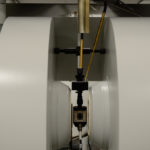
EPR spectrometry
Among the methods used in transfer dosimetry for ionizing radiation metrology, alanine’s electronic paramagnetic resonance spectrometry (EPR) is applied to ensure the traceability of doses in various fields of application, including that of health, which includes several sectors:
- sterilization of single-use products (syringes, prostheses,…) (a few tens of thousands of grays),
- sterilization of blood products (from a few tens to hundreds of grays),
- sterilization of food (provided to immunodeficient patients) (a few thousand grays).
EPR was discovered in 1945 by E. Zavoisky and is today a classic method of analysing the structure of matter used in physics, chemistry, medicine and biology. EPR spectrometry has the advantage of being a non-destructive method, so measurements can be taken on the same sample several days or even years after a first acquisition.
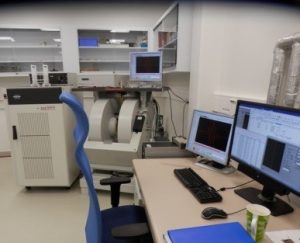
EPR spectrometry is a method based on the resonant absorption of a hyperfrequency wave by a paramagnetic species placed in a magnetic field. This technique makes it possible to measure the concentration of free radicals, in particular those induced by irradiation in organic or inorganic materials.
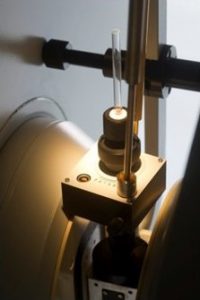
To detect the EPR signal of a sample, it must be placed in a suprasil® quartz tube inserted into the resonant cavity in the center between the two electromagnets.
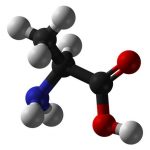
L-α-alanine is one of the 20 amino acids mainly found in peptide chains of proteins having C3H7O2N for raw formula.
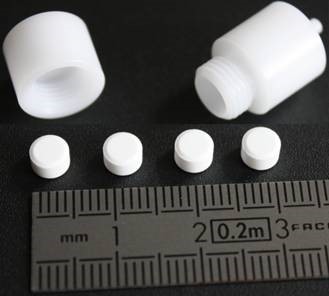
In powder form, alanine is compressed into pellets. The dosimeter used at the LNE-LNHB consists of four pellets packaged in a watertight container.

The irradiation of the alanine pellets creates free radicals whose concentration is measured by EPR.
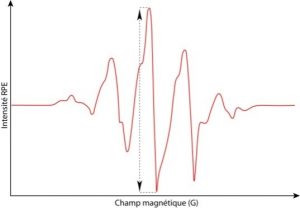
The amplitude of the EPR spectra of alanine is proportional to the concentration of radicals created by irradiation, and thus proportional to the dose received by the alanine pellets.
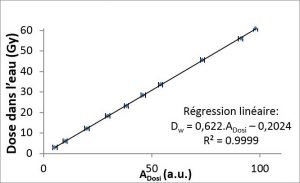
The reference beams of the LNE-LNHB (cobalt-60 and accelerator) are characterized as absorbed dose in water. The irradiation of dosimeters by these beams under reference conditions allows their calibration curve to be established, linking the absorbed dose in water to the corresponding EPR signal.
Alanine dosimeters are conservative, stable and reproducible. Their EPR response is linear as a function of dose. They are good integrators and are not very dependent on dose rate and the quality of radiotherapy beams. The main advantage of alanine lies in its composition, which is very close to that of living tissues and can be considered as tissue equivalent towards radiation. This makes it an excellent tissue equivalent dosimeter in a wide dose range from 5 grays to 100 000 grays. Uncertainties on absorbed dose measurement and air kerma are in the range of 2-3% at k = 2.

The EPR/alanine technique has been used for many years, mainly for the reference dosimetry of high doses: calibration of irradiators, sterilization of medical equipment, food… However, more recently, the technique has been extended to the measurement of lower doses from 2 Gy to 50 Gy, for the transfer of calibration of radiotherapy beams. Dose measurement methodologies adapted to new small beam sections such as helical tomotherapy (Perichon, 2011), CyberKnife® (Garcia, 2011) and GammaKnife® (Hornbeck, 2014) are being developed, particularly for quality control.
Fricke chemical dosimetry
Page under construction…
REFERENCES:
– Garcia T., Lacornerie T., Popoff R., Lourenço V., Bordy J.-M., Dose verification and calibration of the Cyberknife by EPR/alanine dosimetry. Radiation Measurements 2011, Vol. 46, 952-957.
– Hornbeck A., Garcia T., Cuttat M., Jenny C., Absolute calibration of the Gamma Knife® Perfexion™ and delivered dose verification using EPR/alanine dosimetry. Med Phys. 2014, Vol. 41(6), 1-10.
– Perichon N., Garcia T., François P., Lourenço V., Bordy J.-M., Calibration of helical tomotherapy device using EPR/Alanine dosimetry. Med Phys. 2011, Vol. 38(3), 1168-77.
– Zavoisky E., Spin Magnetic Resonance in Paramagnetic Spectroscopy. Journal of Physics (USSR). 1945, Vol. 9, 245–249.
Our job: metrology
dosimetry
Implemented methods for the establishment of national references must be adapted to the radiation type and its intensity. They are based on measurement technics such as calorimetry, ionometry and chemical dosimetry.
Radioactivity
The variety of the emitted radiation and physical forms of the sources oblige to adapt the measurement process in order to establish national references: methods with defined geometries, or 4 π countings geometries, coincidence countings, etc.
